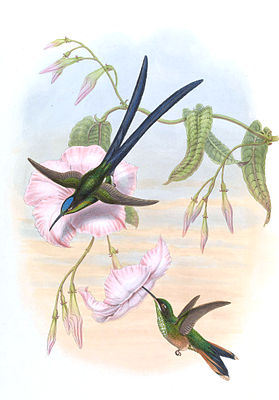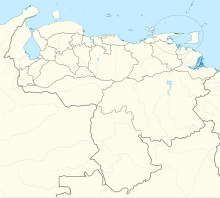Scissortail Nymph
| Scissortail Nymph | ||||||||||
|---|---|---|---|---|---|---|---|---|---|---|

Scissorstail nymph painted by John Gould |
||||||||||
| Systematics | ||||||||||
|
||||||||||
| Scientific name of the genus | ||||||||||
| Hylonympha | ||||||||||
| Gould , 1873 | ||||||||||
| Scientific name of the species | ||||||||||
| Hylonympha macrocerca | ||||||||||
| Gould , 1873 |
The scissor-tailed hummingbird ( Hylonympha macrocerca ) or sometimes wood nymph called, is a species of bird from the family of hummingbirds (Trochilidae). The species has a range that only covers about 375 square kilometers in the South American country Venezuela . The stock is on the IUCN (as "critically endangered" endangered ) classified.
features
The male scissorstail nymph reaches a body length of about 19 centimeters, while the female is only about 11.5 centimeters long. The parting and middle part of the crown of the male is purple. The rest of the crown is black. The top shimmers dark green. The throat and the lower part shine emerald green and turn black on the belly. There are green spots on the side flanks. The very long forked tail is black-purple. The outer control feathers are much longer than the rest of the tail feathers. The female has a dark green shiny upper part. The lower part is white with green flecks. The chest is entirely white. The belly and the lower part of the wings are chestnut colored. The tail is much shorter than that of the male. The inner green tail feathers show distal steel-blue traces. The outer feathers are cinnamon with subterminal dark sections and dirty white spots.
Habitat
The habitat of the hummingbird is in a subtropical zone. It moves at the edges of the forest and clearings in the cloud forest at heights between 900 and 1200 meters. The hummingbird is endemic to the Pariah Peninsula .
behavior
In the primary forest, the bird feeds primarily on the nectar of the bromeliad plants and the insects that live there. In the secondary forest you can also see it on heliconias (especially Heliconia aurea ) and on Costus .
Subspecies
So far no subspecies are known. The species is therefore considered to be monotypical .
Etymology and history of research
John Gould already used today's protonym Hylonympha macrocerca . He received the type specimen from Henry Whitely (1844-1893), who claimed that he had received this with a collection of other bellows from Brazil .
The term »Hylonympha« is derived from the Greek words »hýlē ὕλη « for »forest« and »nymphē, νυμφή « for » nymph , young beauty«. The Greek specific epithet »macrocerca« is a Greek word formation from »makros μακρός « for »big, long« and »kerkos κέρκος « for »tail«.
literature
- Rodolphe Meyer de Schauensee, William H. Phelps , Guy Tudor : A Guide to the Birds of Venezuela. Princeton University Press, Princeton 1992, ISBN 978-0691082059 , p. 148 ff.
- James A. Jobling: Helm Dictionary of Scientific Bird Names . Christopher Helm, London 2010, ISBN 978-1-4081-2501-4 .
- John Gould: On a new Genus and Species of Family Trochilidæ . In: The Annals and magazine of natural history; zoology, botany, and geology being a continuation of the Annals combined with Loudon and Charlesworth's Magazine of Natural History . tape 12 , 1873, p. 429 ( online [accessed June 17, 2012]).
Web links
- Hylonympha macrocerca onthe IUCN 2012 Red List of Threatened Species . Listed by: BirdLife International, 2012. Retrieved July 14, 2012.
- BirdLife International: Species Factsheet - Scissor-tailed Hummingbird ( Hylonympha macrocerca ) . Retrieved July 14, 2012.
- Videos, photos and sound recordings of Scissor-tailed Hummingbird (Hylonympha macrocerca) in the Internet Bird Collection
- Scissorstail nymph ( Hylonympha macrocerca ) at Avibase; Retrieved July 14, 2012.
- Hylonympha macrocerca in the Integrated Taxonomic Information System (ITIS). Retrieved July 14, 2012.
- xeno-canto: Sound recordings - Scissor-tailed Hummingbird ( Hylonympha macrocerca )

